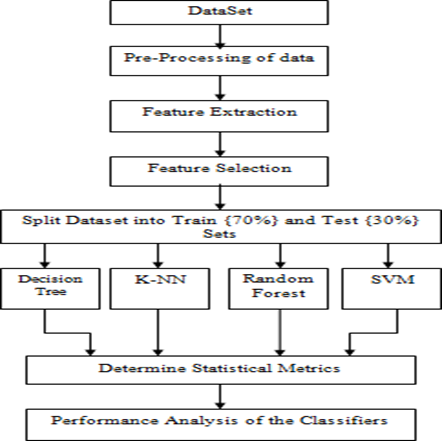A Comprehensive Analysis on Risk Prediction of Heart Disease using Machine Learning Models
Main Article Content
Abstract
Most of the deaths worldwide are caused by heart disease and the disease has become a major cause of morbidity for many people. In order to prevent such deaths, the mortality rate can be greatly reduced through regular monitoring and early detection of heart disease. Heart disease diagnosis has grown to be a challenging task in the field of clinically provided data analysis. Predicting heart disease is a highly demanding and challenging task with pure accuracy, but it is easy to figure out using advanced Machine Learning (ML) techniques. A Machine Learning approach has been shown to predict heart disease in this approach. By doing this, the disease can be predicted early and the mortality rate and severity can be reduced. The application of machine learning techniques is advancing significantly in the medical field. Interpreting these analyzes in this methodology, which has been shown to specifically aim to discover important features of heart disease by providing ML algorithms for predicting heart disease, has resulted in improved predictive accuracy. The model is trained using classification algorithms such as Decision Tree (DT), K-Nearest Neighbors (K-NN), Random Forest (RF), Support Vector Machine (SVM). The performance of these four algorithms is quantified in different aspects such as accuracy, precision, recall and specificity. SVM has been shown to provide the best performance in this approach for different algorithms although the accuracy varies in different cases.
Article Details
References
Singh, A., (2020, February). Heart Disease Prediction Using Machine Learning Algorithms. In 2020 International Conference on Electrical and Electronics Engineering (ICE3) (pp. 452- 457). IEEE
Hashi, E.K. and Zaman, M.S.U., 2020. Developing a Hyperparameter Tuning Based Machine Learning Approach of Heart Disease Prediction. Journal of Applied Science & Process Engineering, 7(2), pp.631-647.
A. Javeed, S. Zhou, L. Yongjian, I. Qasim, A. Noor, and R. Nour, “An Intelligent Learning System Based on Random Search Algorithm and Optimized Random Forest Model for Improved Heart Disease Detection,” IEEE Access, vol. 7, pp. 180235– 180243, 2019, doi: 10.1109/ACCESS.2019.2952107.
S. Mohan, C. Thirumalai, and G. Srivastava, “Effective Heart Disease Prediction Using Hybrid Machine Learning Techniques,” IEEE Access, vol. 7, pp. 81542–81554, 2019, doi: 10.1109/ACCESS.2019.2923707.
L. Ali “An Optimized Stacked Support Vector Machines Based Expert System for the Effective Prediction of Heart Failure,” IEEE Access, vol. 7, pp. 54007–54014, 2019, doi:10.1109/ACCESS.2019.2909969
L. Ali, A. Rahman, A. Khan, M. Zhou, A. Javeed, and J. A. Khan, “An Automated Diagnostic System for Heart Disease Prediction Based on ?2 Statistical Model and Optimally Configured Deep Neural Network,” IEEE Access, vol. 7, pp. 34938–34945, 2019, doi: 10.1109/ACCESS.2019.2904800.
R. Ani, S. Krishna, N. Anju, M. Aslam and O. Deepa, “Iot based patient monitoring and diagnostic prediction tool using ensemble classifier”, in 2017 International Conference on Advances in Computing, Communications and Informatics (ICACCI), Udupi, India, 2017, pp. 1588-1593.
K. Deepika and S. Seema, “Predictive analytics to prevent and control chronic diseases,” Proc. 2016 2nd Int. Conf. Appl. Theor. Comput. Commun. Technol. iCATccT 2016, no. January 2016, pp. 381–386, 2017, doi: 10.1109/ICATCCT.2016.7912028
Hazra, S. Mandal, A. Gupta, and A. Mukherjee, “Heart Disease Diagnosis and Prediction Using Machine Learning and Data Mining Techniques: A Review,” Advances in Computational Sciences and Technology, 2017, 10, 2137-2159.
Ashish Chhabbi, Lakhan Ahuja, Sahil Ahir and Y. K. Sharma, "Heart Disease Prediction Using Data Mining Techniques", IJRAT Special Issue National Conference “NCPC-2016”, pp. 104-106, 19 March 2016.
Soni, Jyoti, "Predictive data mining for medical diagnosis: An overview of heart disease prediction." International Journal of Computer Applications 17.8 (2011): 43-48.
Vanisree K, JyothiSingaraju. Decision support system for congenital heart diseasediagnosis based on signs and symptoms using neural networks. Int J Comput ApplApril 2011;19(6). (0975 8887).
Fida Benish, Nazir Muhammad, Naveed Nawazish, Akram Sheeraz. Heart disease classification ensemble optimization using genetic algorithm. IEEE; 2011. p. 19–25.
Y. Roche, Risques médicaux au cabinet dentaire en pratique quotidienne: Identification patients évaluation risques prise encharge: prévention précautions, 2010.
LathaParthiban, Subramanian R. Intelligent heart disease prediction system usingCANFIS and genetic algorithm. Int.
Satish Kumar Satti, Suganya Devi K., Prasad Maddula, N.V.Vishnumurthy Ravipati, Unified approach for detecting traffic signs and potholes on Indian roads, Journal of King Saud University - Computer and Information Sciences, Volume 34, Issue 10, Part B, 2022, Pages 9745-9756, ISSN 1319-1578, https://doi.org/10.1016/j.jksuci.2021.12.00 6.
Pokkuluri, K. S., & Nedunuri, S. U. D. (2020). A novel cellular automata classifier for covid-19 prediction. Journal of Health Sciences, 10(1), 34-38.
Sree, P. K., Babu, I. R., & Devi, N. U. (2009). Investigating an Artificial Immune System to strengthen protein structure prediction and protein coding region identification using the Cellular Automata classifier. International journal of bioinformatics research and applications, 5(6), 647-662.
Sree, K., & Babu, R. (2010). Identification of Promoter Region in Genomic DNA Using Cellular Automata Based Text Clustering. International Arab Journal of Information Technology (IAJIT), 7(1).
Sree, P. K. (2008). Exploring a novel approach for providing software security using soft computing systems. International Journal of Security and Its Applications, 2(2), 51-58.
Mangalampalli, S., Sree, P. K., Swain, S. K., & Karri, G. R. (2023). Cloud Computing and Virtualization. Convergence of Cloud with AI for Big Data Analytics: Foundations and Innovation, 13-40.
Pokkuluri, K. S., Nedunuri, S. U. D., & Devi, U. (2022). Crop Disease Prediction with Convolution Neural Network (CNN) Augmented With Cellular Automata. INTERNATIONAL ARAB JOURNAL OF INFORMATION TECHNOLOGY, 19(5), 765-773.

